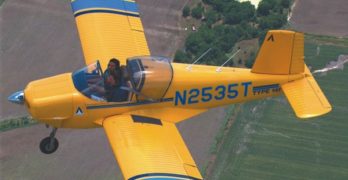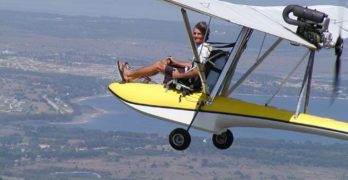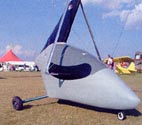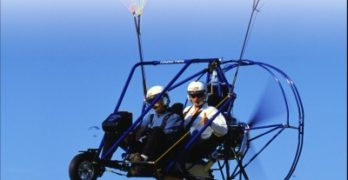ST. PAUL, MINN. — As this issue went to press, the Christmas cards and calls were
arriving as usual. One call was a flashback to precisely two years ago, when in this
column (Feb. ’03) I wrote a farewell to longtime Hang Gliding editor, Gil
Dodgen. So, perhaps it was fitting that he should call recently.
Gil was charged up over a big success by his employer of the last couple years. Vertigo
is an aviation and defense developer and they’d just done a specialized parachute
drop that hit the target perfectly. The SoCal company creates solutions and has found
answers when others couldn’t to create a successful enterprise. This is no surprise
as Vertigo has quite a brain trust so the addition of software writer Dodgen was
quite appropriate. In addition to Glen Brown, who you may not know, Vertigo’s staff
is “hang gliding heavy.” Brown’s founding partner is CEO Roy Haggard whose
most notable hang gliding claim to fame was developing the UP Comet, a glider
widely believed to have forever changed the design of hang gliders.
Search Results for : Flight Design
Not finding exactly what you expected? Try our advanced search option.
Select a manufacturer to go straight to all our content about that manufacturer.
Select an aircraft model to go straight to all our content about that model.
Thorp T-211
Thorp T-211 Sport E
From the world of general aviation aircraft comes an entry to the proposed Light-Sport Aircraft (LSA) category. Presently known as the Thorp T-211, the all-metal airplane will be called the Thorp T-211 Sport E when it makes its debut as a light-sport aircraft.
Famed designer John Thorp is perhaps best known for his work leading to the Piper Cherokee series and the T-18 homebuilt. His work on a design that became the T-211 started back in the 1940s before general aviation planes had transportation as their primary goal. When the T-211 was first created – as the T-11 Skooter and later the T-111 – it was intended to become competition for the Cessna 150. The T-211 is a light plane, tipping the scales at hundreds of pounds less than Cessna’s smallest model and so it was expected to perform better.
Under new management since 2003, Thorp’s design is ready to make the leap to the Sport E.
Connie Amphib — “The Flying Float” (and it is!)
Check out Bobbie Bailey’s Connie Amphib.
Many pilots are aware of aircraft referred to as flying boats. Among ultralight aircraft, the Aventura, SeaRey and Buccaneer stand out as good examples as do trikes like Polaris’ Flying Inflatable Boat. The flying boat reference describes those aircraft built around a boat hull with substantially different structure than airplanes equipped with two floats.
That clear definition is blurred by the introduction of a novel new ultralight from the inventive mind of Bobbie Bailey. His new Connie amphibian is neither flying boat nor a float-equipped ultralight. My BRS associate, Gregg Ellsworth, tagged it a “flying float.” Works for me.
Canada’s Lotus Float company offers a single float setup that functions much the same way but is an add-on to a wheeled ultralight. This may make a perfectly fine floatplane, but you have to do the fitting yourself, and it simply won’t be as elegant as Bailey’s Connie amphib.
Part 103 Ultralight Trikes
Part 103 ultralight trikes aim at soaring pilots.
Many visitors to Oshkosh AirVenture 2003 expected the FAA to announce its new sport pilot/light-sport aircraft rule. New Administrator Marion Blakey reported signing off on the rule on July 30, but with two other agencies in line to review it, we aren’t likely to see the final version until 2004.
Visitors may not have expected to see more than a few Part 103 ultralight aircraft at AirVenture (some thought they would disappear as LSA approaches). But there were many. Next month I’ll write about two Part 103 rotary-wing aircraft, but this time, the subject is nanotrikes.
Nanotrike is a term to describe extremely light wheeled structures combining powered paraglider engines and contemporary hang glider wings. The idea is to create a low-cost, self-launching ultralight motorglider.
Trike Pod
Minnesota-based Seagull Aerosports debuted its Escape Pod at Oshkosh. Pushed by a single-cylinder Cors-Air engine generating 25 hp, the Escape Pod weighs only 75 pounds.
Timeline.
September 2004-Rule effective
Current pilots can begin exercising privileges of sport pilot certificate.
Non-current pilots can begin exercising privileges of sport pilot certificate after obtaining flight review and currency requirements for the category of aircraft they will fly as sport pilots.
Ultralights pilots must be registered with an exemptionholding organization (EAA, ASC, USUA) to receive full credit for ultralight knowledge and training. October 1 2004
Ultralight owners can apply for an N-number for previously unregistered/uncertificated vehicles. Application form will be available online at http://afs600.faa.gov. Sometime during October 2004
Practical test standards (PTS) for flight testing and knowledge (written) tests will be available (for study).
Guidelines for repairman training will be available.
Designated pilot examiner (DPE) and designated airworthiness representative (DAR) applications will be accepted.
November/December 2004
First FAA DAR training courses will be conducted.
January 2005
FAA ready to issue:
Sport pilot certificates.
Sport pilot certified flight instructor (CFI) certificate
Private pilot weight-shift and powered parachute ratings.
Transitioning?
A primer for ultralight pilots transitioning themselves and their machines
Ultralight pilots flying legal Part 103 single-place ultralights are not affected by the sport pilot/light-sport aircraft rule. The rules of FAR Part 103 remain the same. Current and future ultralight pilots are free to enjoy those freedoms. If they choose to become sport pilots at a later date, any training logged as a registered ultralight pilot can be counted toward the training requirements for a sport pilot certificate. The rule pertaining to legal ultralight vehicles also do not change.
The sport pilot and lightsport aircraft (SP/LSA) rule is now officially part of the American aviation culture. Some of us who fly Part 103-legal ultralights will continue to be ultralight pilots. Others who fly two-place or overweight machines must eventually transition themselves to sport pilot status and their machines to light-sport aircraft status to remain legal.
With the rule now final, we’ll address the requirements for those ultralight pilots and instructors wishing to transition themselves and their machines.
Product Lines – December 2004
WALLABY RANCH, FL — While northerners prepare for winter and snow, it’s hot and
sunny here in Florida. I’m in the state for a collection of aviation events, kicked
off by a big gathering at Malcolm Jones’ “Ranch.”
They called it the Moyes Boys Reunion. When most of us hear “reunion” we think
of Class Reunions, and many groan about having to attend. Since I similar gatherings
like Dockweiler and Grandfather Mountain, I was pleased to make this one. I saw old
friends I hadn’t seen in 20+ years. But what really moved me was meeting John
Dickenson, who may have been THE man who invented the hang glider as we
know it today. John taught both Bill Moyes and Bill Bennett
to fly “ski kites” as they were then called. Moyes went on to become a major brand
name. Bill Bennett once directed a leading company that gave Bob Wills his start
in the business.
Product Lines – August 2004
ST. PAUL, MINN. — Wow! Feel the chill! Am I nuts, talking about chill in August?
Even in my home state of Minnesota (just south of the Arctic), it’s summer and steamy
with mosquitoes the size of B-52s. However, the year-round conditions on top of Mount
Everest never get steamy| except maybe when a powered ultralight trike puts on an
airshow for hardy mountain climbers who made it to the world’s highest peak. This
news was first reported at the end of May by AvWeb.com, an Internet-only aviation
news outlet (bold emphasis is mine).
Headline: “MICROLIGHT CONQUERS EVEREST — So, what would you do if the turbo-intercooled
Rotax 914 engine powering your Pegasus Quantum trike, flying under a Pegasus
XL wing, was so hard to start that it flattened two batteries before finally catching?
Perhaps they were mildly hypoxic, but Angelo D’Arrigo and Richard Meredith-Hardy
chose to fly that engine (typically capable of 115 hp) over the world’s highest mountain
— towing a hang glider (a rigid-wing ATOS 2 from Icaro 2000) for good
measure.
Product Lines – June 2004
CENTRAL FLORIDA–
At the start of the big Sun ‘n Fun airshow, I had the pleasure to fly John
Dunham’s American Tug built for him by ultralight producer, M Squared
of Alabama. This design resembles the popular Quicksilver ultralights that evolved
from the original hang glider of the late 1970s. Beefed up for the hard duty that
is aero towing, the M Squared entry is a robust ultralight that should be capable
of steady operation as a tractor of the air. American Tug is a single-place aircraft
employing a 32-foot span, high-lift, slow-flying, single-surface, strut-braced wing.
While Dragonfly has been the lone fixed-wing tug in the USA, flight parks and clubs
now have another choice. And, importantly, the American Tug — as opposed to the
“Australian tug,” John says — costs substantially less. A basic Rotax 582-powered
tug should sell for about $20,000 says John. The American
Tug I flew, with a custom-configured 680 cc Rotax engine rated at 100 hp, demonstrated
an acceptable climb rate while towing plus excellent low speed controllability.
Product Lines – April 2004
St. Paul, Minn. — You’ll probably be amazed to hear that Wallaby Ranch and Quest
have merged. Yes, unbelievably, the two rivals flight parks signed an agreement
to become as one. This stunning development comes just
after Wills Wing purchased Moyes “for a song” crooned WW president, Rob Kells.
“It seemed like a good idea at the time,” he added. How much more shocking news can
you withstand? Well, in keeping with a few fun items elsewhere in this magazine,
the above is pure April Fools fiction. I’ll leave more inventive humor to others
and return to what this column does best.
Amid all the excitement, I completely forgot to blow my own horn| Yup, with the February
2004 issue, “Product Lines” finished 25 years of continuous publishing. In
all that time, the column never missed an issue. As I am working to post all
these columns on my long-in-development Web site, someday you’ll be able to scan
through a lot of hang gliding history presented in a familiar format.
- « Previous Page
- 1
- …
- 123
- 124
- 125
- 126
- 127
- …
- 147
- Next Page »





